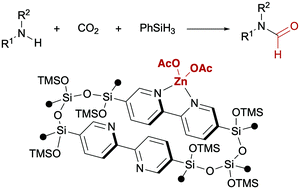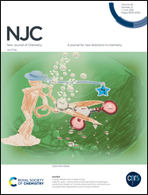Immobilized Zn(OAc)2 on bipyridine-based periodic mesoporous organosilica for N-formylation of amines with CO2 and hydrosilanes†
Abstract
Zinc acetate (Zn(OAc)2) was successfully immobilized on a bipyridine-based periodic mesoporous organosilica (BPy-PMO-TMS), as confirmed by solid-state NMR and energy-dispersive X-ray spectroscopies, X-ray diffractometry, and nitrogen adsorption/desorption isotherm analyses. The immobilized Zn complex, Zn(OAc)2(BPy-PMO-TMS), exhibited good catalytic activity during the N-formylations of amines and amides with CO2 and PhSiH3 to produce the corresponding formamides. Zn(OAc)2(BPy-PMO-TMS) with a lower Zn loading was found to exhibit higher catalytic activity.



 Please wait while we load your content...
Please wait while we load your content...